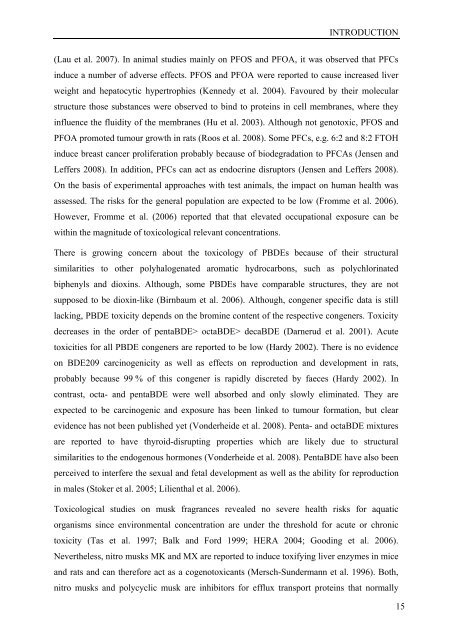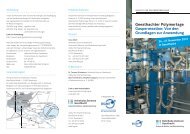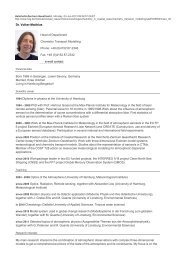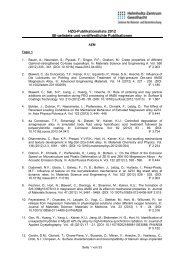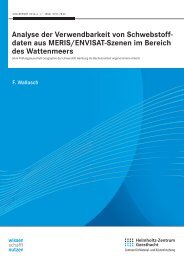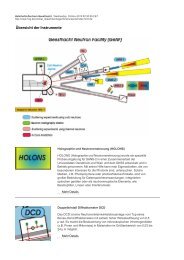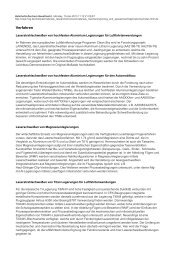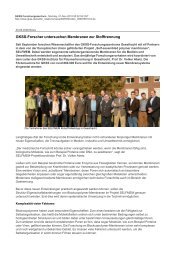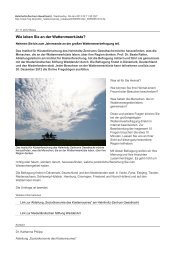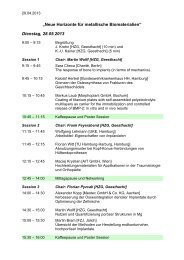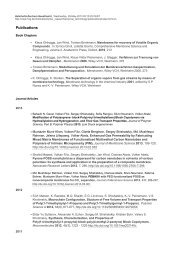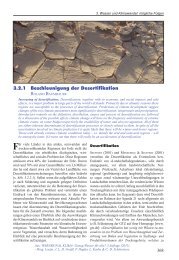Landfills and waste water treatment plants as sources of ... - GKSS
Landfills and waste water treatment plants as sources of ... - GKSS
Landfills and waste water treatment plants as sources of ... - GKSS
Create successful ePaper yourself
Turn your PDF publications into a flip-book with our unique Google optimized e-Paper software.
INTRODUCTION<br />
(Lau et al. 2007). In animal studies mainly on PFOS <strong>and</strong> PFOA, it w<strong>as</strong> observed that PFCs<br />
induce a number <strong>of</strong> adverse effects. PFOS <strong>and</strong> PFOA were reported to cause incre<strong>as</strong>ed liver<br />
weight <strong>and</strong> hepatocytic hypertrophies (Kennedy et al. 2004). Favoured by their molecular<br />
structure those substances were observed to bind to proteins in cell membranes, where they<br />
influence the fluidity <strong>of</strong> the membranes (Hu et al. 2003). Although not genotoxic, PFOS <strong>and</strong><br />
PFOA promoted tumour growth in rats (Roos et al. 2008). Some PFCs, e.g. 6:2 <strong>and</strong> 8:2 FTOH<br />
induce bre<strong>as</strong>t cancer proliferation probably because <strong>of</strong> biodegradation to PFCAs (Jensen <strong>and</strong><br />
Leffers 2008). In addition, PFCs can act <strong>as</strong> endocrine disruptors (Jensen <strong>and</strong> Leffers 2008).<br />
On the b<strong>as</strong>is <strong>of</strong> experimental approaches with test animals, the impact on human health w<strong>as</strong><br />
<strong>as</strong>sessed. The risks for the general population are expected to be low (Fromme et al. 2006).<br />
However, Fromme et al. (2006) reported that that elevated occupational exposure can be<br />
within the magnitude <strong>of</strong> toxicological relevant concentrations.<br />
There is growing concern about the toxicology <strong>of</strong> PBDEs because <strong>of</strong> their structural<br />
similarities to other polyhalogenated aromatic hydrocarbons, such <strong>as</strong> polychlorinated<br />
biphenyls <strong>and</strong> dioxins. Although, some PBDEs have comparable structures, they are not<br />
supposed to be dioxin-like (Birnbaum et al. 2006). Although, congener specific data is still<br />
lacking, PBDE toxicity depends on the bromine content <strong>of</strong> the respective congeners. Toxicity<br />
decre<strong>as</strong>es in the order <strong>of</strong> pentaBDE> octaBDE> decaBDE (Darnerud et al. 2001). Acute<br />
toxicities for all PBDE congeners are reported to be low (Hardy 2002). There is no evidence<br />
on BDE209 carcinogenicity <strong>as</strong> well <strong>as</strong> effects on reproduction <strong>and</strong> development in rats,<br />
probably because 99 % <strong>of</strong> this congener is rapidly discreted by faeces (Hardy 2002). In<br />
contr<strong>as</strong>t, octa- <strong>and</strong> pentaBDE were well absorbed <strong>and</strong> only slowly eliminated. They are<br />
expected to be carcinogenic <strong>and</strong> exposure h<strong>as</strong> been linked to tumour formation, but clear<br />
evidence h<strong>as</strong> not been published yet (Vonderheide et al. 2008). Penta- <strong>and</strong> octaBDE mixtures<br />
are reported to have thyroid-disrupting properties which are likely due to structural<br />
similarities to the endogenous hormones (Vonderheide et al. 2008). PentaBDE have also been<br />
perceived to interfere the sexual <strong>and</strong> fetal development <strong>as</strong> well <strong>as</strong> the ability for reproduction<br />
in males (Stoker et al. 2005; Lilienthal et al. 2006).<br />
Toxicological studies on musk fragrances revealed no severe health risks for aquatic<br />
organisms since environmental concentration are under the threshold for acute or chronic<br />
toxicity (T<strong>as</strong> et al. 1997; Balk <strong>and</strong> Ford 1999; HERA 2004; Gooding et al. 2006).<br />
Nevertheless, nitro musks MK <strong>and</strong> MX are reported to induce toxifying liver enzymes in mice<br />
<strong>and</strong> rats <strong>and</strong> can therefore act <strong>as</strong> a cogenotoxicants (Mersch-Sundermann et al. 1996). Both,<br />
nitro musks <strong>and</strong> polycyclic musk are inhibitors for efflux transport proteins that normally<br />
15


